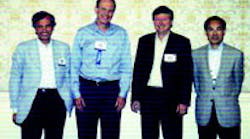companies, and university research centers is now a pressing business need. One executive explained that Europe already has a well-established system of common pre-competitive research with universities and research institutes. And Bruce H. Williams of U.S. Tool Grinding Inc., Delslage, Mo., and USCTI president, added, We have cooperated on certain projects with the University of South Carolina. It is effective when seven or eight companies band together to fund a project, and all companies benefit from a solution. Attendees from both large corporations and small businesses indicated that competitiveness still exists, but they find themselves cooperating more, and not just to fund research projects. Held up as a prime example, the cutting tool industry often partners with the machine tool industry to keep pace with developments such as multitasking machines. An additional concern of U.S., European, and Japanese companies centered on economic recovery. William Strauss, senior economist and economic advisor of the Federal Reserve Bank of Chicago, reported that despite the shock waves that have hit the U.S. economy over the last few years, productivity growth has been strong, and manufacturing output has recovered 68% of its decline and is just 2.2% from its June 2000 peak. It was also explained that in 1998 and 1999, the machine tools, aerospace, farm equipment, and automotive industries were hitting on all cylinders at the same time and the chances of everyone being in good shape at the same time again probably wont happen for awhile, particularly the machine tool industry. But appearances can be deceiving. While 2006 is expected to be a bit on the flat side, companies will still hire people, buy new equipment, and ramp up production. A composite of a number of government leading indicators predicts a modest recovery over the next few years. ECTA President, Fabrizio Resmini, of Dormer Italia SpA Milan, Italy, indicated some unease in the European sector over increased costs, and JCTA President Makoto Takeuchi, of Hitachi Tool Engineering, Tokoyo, Japan spoke of the Japanese desire to increase exports to the U.S. and Europe. All three executives expressed concern over the high number of exports going to China. It was pointed out that export figures are estimated as higher than production figures and a reason for this could be ongoing specialization. Specialized companies now serve customers all over the world. In addition, one executive said that India would be an interesting market in about three to five years. Conference members also commented on the need for global cooperationin recognizing worldwide standards. Jonas Nordstrom of Sandvik Coromant, Fairlawn, N.J., Lee Youthers of Kennametal, Latrobe, Pa., and Norman Swindells of the U.K.-based Ferroday Ltd. gave a presentation on ISO 13399, a new standard that describes modern cutting tools. And technology such as CAD, CAM, and PDM systems, as well as advancements in production simulation, tool presetting, and enterprise resource planning, mean a greater role for computer systems in cutting tool selection. Modern tools can also have multiple functions based on the demands of multitasking machines. This means new standards containing more information are required to explain the capabilities of products controlled by computer systems. Shared collaboration and economic issues did not damper anyones enthusiasm to see new products in action. Dr. Dirk Friedrich, from Germanys WZL Laboratory for Machine Tools and Production Engineering at the University of Technology, Aachen, gave a presentation on Conference-goers learn about global business concerns. experimental cutting tool geometries that addressed the paradox inherent in grinding carbide inserts with grinding wheels. Dr. Friedrich explained, In a grinding process, you want the grit to win, while in a cutting process you want the insert to win. This leads to questions as to how to best make an insert or a cutting tool with the most efficient processes. Friedrich commented that opportunities abound in virtual machining, which allows simulated trials with tool geometries so crazy no one could believe they would remove anything. Simulated trials let companies closely analyze chip creation, including the surfaces behind chips. Thats because virtual reality can be stopped mid-process, not possible on a real machine. As Friedrich said, You can examine your insert and see how it behaves from temperature extremes to high stresses. And you can see the stresses of the chip on your workpiece. While wear of geometries can never be totally avoided, new geometries are minimizing crater wear. Participants also discussed recent developments in HSS coated with powdered metal. Williams commented, The development work in powdered-metal technology will allow an extension of HSS use. It will be interesting to see how effective this is because powdered metal is currently expensive. But this technology allows higher high-end hardness, and the tool is less brittle. Also, these tools dont require quite as rigid a machine, so they work on older equipment. And there is still a lot of production that takes place on older equipment with four spindles. Resmini agreed, adding, Newer equipment lets you benefit from carbide inserts. But we have a huge market of medium-sized companies that are not into big-batch production. Theyre more concerned with tool life than cutting performance. In this case, well-coated HSS can compete with carbide.
OF The cutting tool industry focused on global concerns at its third world conference. OPPORTUNITY
By The AMERICAN MACHINIST staff






